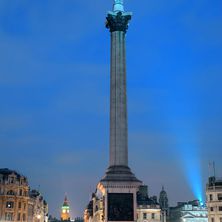

Yet despite losing no ships, England suffered a major loss that day – Nelson himself, who was killed by a French bullet while leading his men on deck. Nelson became one of Britain's best-loved military heroes, and yet his private life was scandalous – he was involved in a long affair with a married woman, the society beauty Emma Hamilton. Surprisingly, none of this prevented Nelson being made the hero of Trafalgar Square – look, there he is! On top of the enormous column in the centre of the square, enjoying the best view of central London. Nelson also entered the history of communications on the day of the Battle of Trafalgar. In those days, ships communicated with each other by flags, flown from the upper rigging. Nelson intended to communicate an order to his men before battle, 'ordering' them to fight bravely. But the codebook of flags lacked some words of Nelson's order, so he authorized Flag Officer Pascoe to improvise an alternative. The final message – 'England Expects That Every Man This Day Shall Do His Duty' – was enthusiastically received as a patriotic greeting by his men - and remains one of the most famous messages ever sent. A peculiar fact about Nelson's column emerged after World War Two – apparently Hitler had signed orders that the column should be dismantled and removed to Berlin, once his planned conquest of Britain was complete. As you can see, the column is still in London! In a long-lasting tradition, Norway sends a huge Christmas Tree to Britain as a gift each year, in thanks for Britain's support during World War Two. The tree used to be decorated and placed in the centre of the square 12 days before Christmas each year.